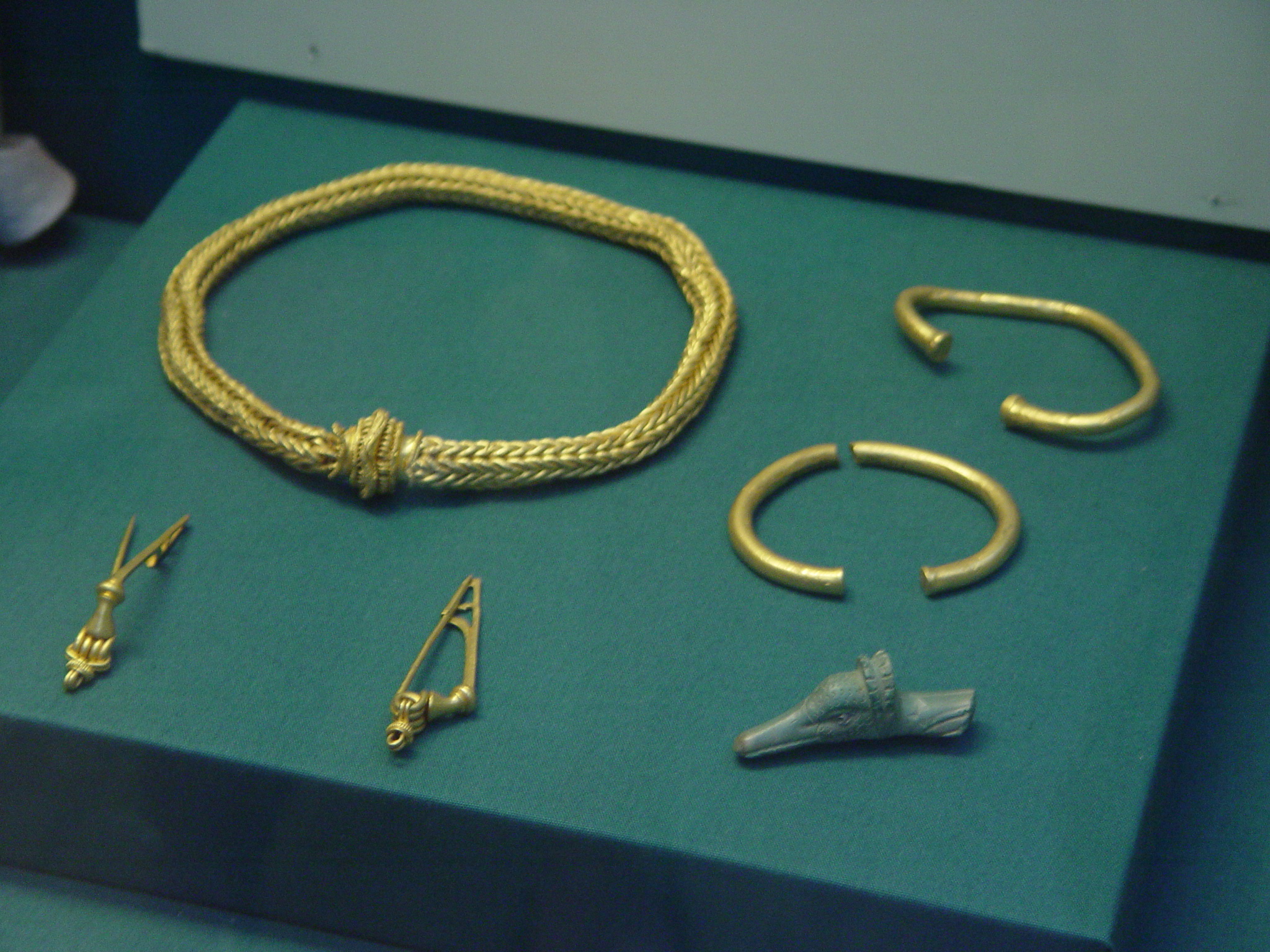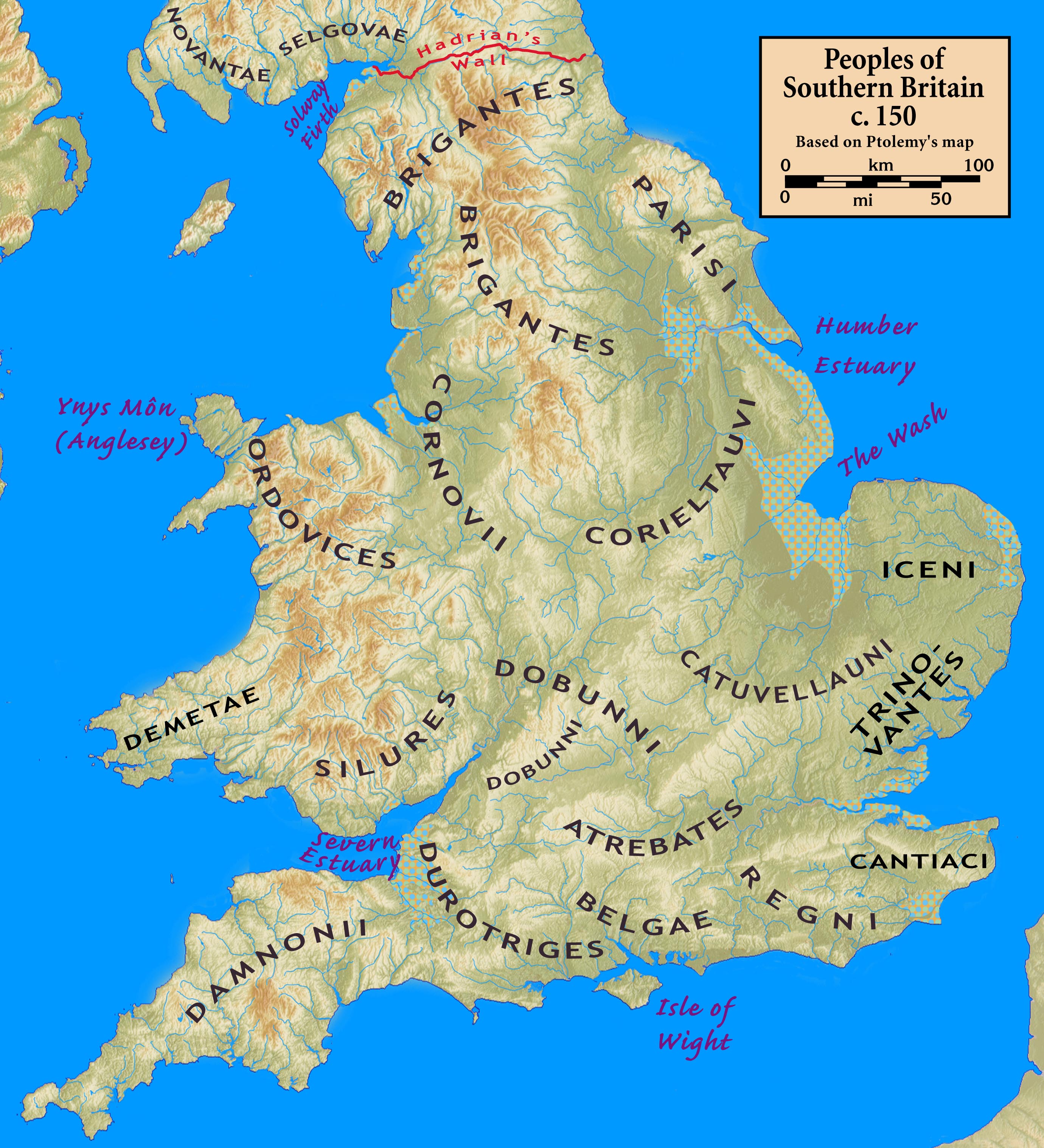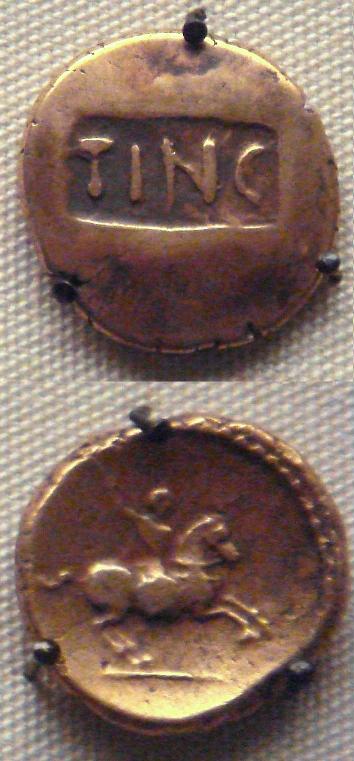|
Eppillus
Eppillus (Celtic: "little horse") was the name of a Roman client king of the Atrebates tribe of the British Iron Age. He appears to have ruled part of the territory that had previously been held by Commius, the Gaulish former ally of Julius Caesar who fled to Britain following the uprising of Vercingetorix, or possibly of his son. Eppillus is not mentioned in any historical sources. Coins bearing his name also bear the inscription COMMI.FILI which is generally read as ''Commios filius'' indicating at least a claim to be Commius's son. After Commius's death in about 20 BC, based on numismatic evidence, Eppillus seems to have ruled jointly with another ruler named Tincomarus. The COMMI.FILI inscription also appears on Tincomarus's coins suggesting they could have been brothers. Eppillus's capital was Noviomagus Reginorum (Chichester) in the south of the kingdom, while Tincomarus ruled from Calleva Atrebatum ( Silchester) in the north. Eppillus became ruler of the whole territor ... [...More Info...] [...Related Items...] OR: [Wikipedia] [Google] [Baidu] |
Atrebates
The Atrebates (Gaulish: *''Atrebatis'', 'dwellers, land-owners, possessors of the soil') were a Belgic tribe of the Iron Age and the Roman period, originally dwelling in the Artois region. After the tribes of Gallia Belgica were defeated by Caesar in 57 BC, 4,000 Atrebates participated in the Battle of Alesia in 53, led by their chief Commius. They revolted again in 51 BC, after which they maintained a friendly relationship with Rome, as Commius received sovereignty over the neighbouring Morini. The quality of their woollens is still mentioned in 301 AD by Diocletian's Price Edict. An offshoot of the Belgic tribe probably entered Britain before 54 BC, where it was successively ruled by kings Commius, Tincommius, Eppillus and Verica. After 43 AD, only parts of the area were still controlled by king Claudius Cogidubnus, after which they fell under Roman power. Name They are mentioned as ''Atrebates'' by Caesar (mid-1st c. BC) and Pliny (1st c. AD), ''Atrebátioi'' (Ἀτρ� ... [...More Info...] [...Related Items...] OR: [Wikipedia] [Google] [Baidu] |
Commius
Commius (Commios, Comius, Comnios) was a king of the Belgic nation of the Atrebates, initially in Gaul, then in Britain, in the 1st century BC. Ally of Caesar When Julius Caesar conquered the Atrebates in Gaul in 57 BC, as recounted in his ''Commentarii de Bello Gallico'', he appointed Commius as king of the tribe. Before Caesar's first expedition to Britain in 55 BC, Commius was sent as Caesar's envoy to persuade the Britons not to resist him, as Caesar believed he would have influence on the island. However he was arrested as soon as he arrived. When the Britons failed to prevent Caesar from landing, Commius was handed over as part of the negotiations. Commius was able to provide a small detachment of cavalry from his tribe to help Caesar defeat further British attacks. During Caesar's second expedition to Britain Commius negotiated the surrender of the British leader Cassivellaunus. He remained Caesar's loyal client through the Gaulish revolts of 54 BC, and in return Caesar ... [...More Info...] [...Related Items...] OR: [Wikipedia] [Google] [Baidu] |
Cantiaci
The Cantiaci or Cantii were an Iron Age Celtic people living in Britain before the Roman conquest, and gave their name to a '' civitas'' of Roman Britain. They lived in the area now called Kent, in south-eastern England. Their capital was ''Durovernum Cantiacorum'', now Canterbury. They were bordered by the Regni to the west, and the Catuvellauni to the north. Julius Caesar landed in Cantium in 55 and 54 BCE, the first Roman expeditions to Britain. He recounts in his ''De Bello Gallico'' v. 14: Rulers Pre-Roman Iron Age Julius Caesar named five Celtic tribes inhabiting the land that would become the "heartland of the Catuvellauni": the Ancalites, the Bibroci, the Cassi, the Cenimagni, and the Segontiaci, each with their own "king" or chieftain. He found their way of life to be very similar to their cousins in Gaul with whom they were close – the invasion of Britain may have been triggered by the Britons' supply of arms to the Gauls, who were being subjug ... [...More Info...] [...Related Items...] OR: [Wikipedia] [Google] [Baidu] |
Verica
Verica (early 1st century AD) was a British client king of the Roman Empire in the years preceding the Claudian invasion of 43 AD. From his coinage, he appears to have been king of the, probably Belgic, Atrebates tribe and a son of Commius. The distribution of his coins also shows that Verica's kingdom was centred on modern Sussex and east Hampshire, and its capital would have been in or close to what became the Roman Noviomagus Reginorum (modern Chichester). He succeeded his elder brother Eppillus as king in about 15 AD, and may also have reigned over the northern Atrebatic kingdom at Calleva Atrebatum, today called Silchester. He was recognised as '' rex'' by Rome and appears to have had friendly trade and diplomatic links with the empire. His territory was pressed from the east by the Catuvellauni, led by Epaticcus, brother of Cunobelinus,_who_conquered_Calleva_in_about_25_AD._After_Epaticcus's_death_ca._35_AD_Verica_regained_some_territory,_but_Cunobelinus's_son_Caratacus.h ... [...More Info...] [...Related Items...] OR: [Wikipedia] [Google] [Baidu] |
Roman Client Kingdoms In Britain
The Roman client kingdoms in Britain were native tribes which chose to align themselves with the Roman Empire because they saw it as the best option for self-preservation or for protection from other hostile tribes. Alternatively, the Romans created (or enlisted) some client kingdoms when they felt influence without direct rule was desirable. Client kingdoms were ruled by client kings. In Latin these kings were referred to as ''rex sociusque et amicus'', which translates to "king, ally, and friend". The type of relationships between client kingdoms and Rome was reliant on the individual circumstances in each kingdom. The beginnings of the system are to be found in Caesar's re-enthroning of Mandubracius as king of the Trinovantes, who had been dethroned by Cassivellaunus and then aided Caesar's second invasion of Britain in 54 BC. The system further developed in the following hundred years, particularly under Augustus's influence, so that by the time of the Roman invasion in 43 A ... [...More Info...] [...Related Items...] OR: [Wikipedia] [Google] [Baidu] |
Tincomarus
Tincomarus (a dithematic name form typical of insular and continental Celtic onomastics, analysable as ''tinco-'', perhaps a sort of fish f Latin ''tinca'', English ''tench''+ ''maro-'', "big") was a king of the Iron Age Belgic tribe of the Atrebates who lived in southern central Britain shortly before the Roman invasion. His name was previously reconstructed as Tincommius, based on abbreviated coin legends and a damaged mention in Augustus's '' Res Gestae'', but since 1996 coins have been discovered which give his full name. He was the son and heir of Commius and succeeded his father around 25-20 BC. Based on coin distribution it is possible that Tincomarus ruled in collaboration with his father for the last few years of Commius's life. Little is known of his reign although numismatic evidence suggests that he was more sympathetic to Rome than his father was in later years: the coins he issued much more closely resemble Roman types, and are made in such a way they may have come f ... [...More Info...] [...Related Items...] OR: [Wikipedia] [Google] [Baidu] |
Caesar Augustus
Caesar Augustus (born Gaius Octavius; 23 September 63 BC – 19 August AD 14), also known as Octavian, was the first Roman emperor; he reigned from 27 BC until his death in AD 14. He is known for being the founder of the Roman Principate, which is the first phase of the Roman Empire, and Augustus is considered one of the greatest leaders in human history. The reign of Augustus initiated an imperial cult as well as an era associated with imperial peace, the ''Pax Romana'' or '' Pax Augusta''. The Roman world was largely free from large-scale conflict for more than two centuries despite continuous wars of imperial expansion on the empire's frontiers and the year-long civil war known as the "Year of the Four Emperors" over the imperial succession. Originally named Gaius Octavius, he was born into an old and wealthy equestrian branch of the plebeian ''gens'' Octavia. His maternal great-uncle Julius Caesar was assassinated in 44 BC, and Octavius was named in Caesar ... [...More Info...] [...Related Items...] OR: [Wikipedia] [Google] [Baidu] |
Dubnovellaunus
Dubnovellaunus or Dumnovellaunus was the name of at least one, and possibly several kings of south-eastern Britain in the late 1st century BC/early 1st century AD, known from coin legends and from a mention in the ''Res Gestae Divi Augusti''. *Dubnovellaunus is the name of a king who, based on coin distribution, appears to have ruled over Kent east of the River Medway. He was the first king of the Cantiaci to issue inscribed coins: some of his coins appear to date from as early as 40-30 BC. Towards the end of the 1st century BC he seems to have been succeeded by a king called Vodenos or Vosenios, although it is possible the two kings' reigns were contemporary or overlapped. *A king called Dubnovellaunus succeeded his father Addedomarus as king of the Trinovantes ca. 10-5 BC and ruled for several years before being supplanted by Cunobelinus_of_the_Catuvellauni.html" ;"title="ymbeline/nowiki>_(d._''c' ... of the Catuvellauni">ymbeline/nowiki>_(d._''c' ... of the Catuvellauni. *In the ... [...More Info...] [...Related Items...] OR: [Wikipedia] [Google] [Baidu] |
Kent
Kent is a county in South East England and one of the home counties. It borders Greater London to the north-west, Surrey to the west and East Sussex to the south-west, and Essex to the north across the estuary of the River Thames; it faces the French department of Pas-de-Calais across the Strait of Dover. The county town is Maidstone. It is the fifth most populous county in England, the most populous non-Metropolitan county and the most populous of the home counties. Kent was one of the first British territories to be settled by Germanic tribes, most notably the Jutes, following the withdrawal of the Romans. Canterbury Cathedral in Kent, the oldest cathedral in England, has been the seat of the Archbishops of Canterbury since the conversion of England to Christianity that began in the 6th century with Saint Augustine. Rochester Cathedral in Medway is England's second-oldest cathedral. Located between London and the Strait of Dover, which separates England from mainla ... [...More Info...] [...Related Items...] OR: [Wikipedia] [Google] [Baidu] |
Dover
Dover () is a town and major ferry port in Kent, South East England. It faces France across the Strait of Dover, the narrowest part of the English Channel at from Cap Gris Nez in France. It lies south-east of Canterbury and east of Maidstone. The town is the administrative centre of the Dover District and home of the Port of Dover. Archaeological finds have revealed that the area has always been a focus for peoples entering and leaving Great Britain, Britain. The name derives from the River Dour that flows through it. In recent times the town has undergone transformations with a high-speed rail link to London, new retail in town with St James' area opened in 2018, and a revamped promenade and beachfront. This followed in 2019, with a new 500m Pier to the west of the Harbour, and new Marina unveiled as part of a £330m investment in the area. It has also been a point of destination for many illegal migrant crossings during the English Channel migrant crossings (2018-present) ... [...More Info...] [...Related Items...] OR: [Wikipedia] [Google] [Baidu] |
Stater
The stater (; grc, , , statḗr, weight) was an ancient coin used in various regions of Ancient Greece, Greece. The term is also used for similar coins, imitating Greek staters, minted elsewhere in ancient Europe. History The stater, as a Greek silver currency, first as ingots, and later as coins, circulated from the 8th century BC to AD 50. The earliest known stamped stater (having the mark of some authority in the form of a picture or words) is an electrum turtle coin, struck at Aegina that dates to about 650 BC. It is on display at the Bibliothèque Nationale in Paris. According to Robin Lane Fox, the stater as a weight unit was borrowed by the Euboean stater weighing from the Phoenician shekel, which had about the same weight as a stater () and was also one fiftieth of a Mina (unit), mina.Lane Fox, Robin. ''Travelling Heroes: Greeks and Their Myths in the Epic Age of Homer''. P. 94. London: Allen Lane, 2008. The silver stater minted at CorinthSmith, William ... [...More Info...] [...Related Items...] OR: [Wikipedia] [Google] [Baidu] |




